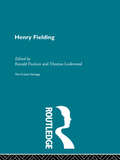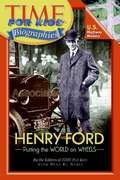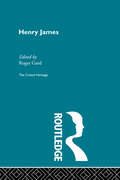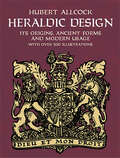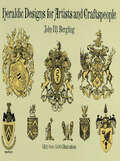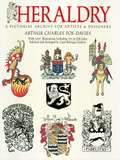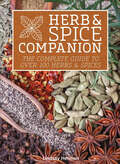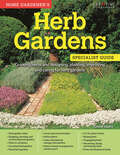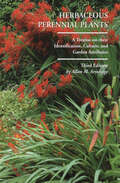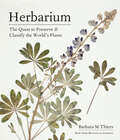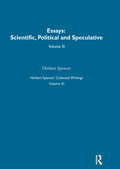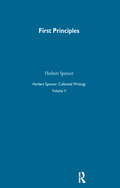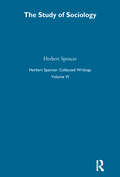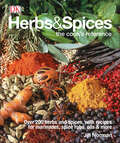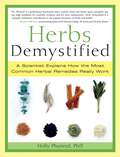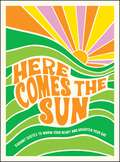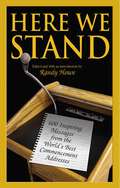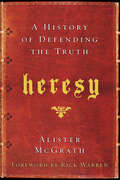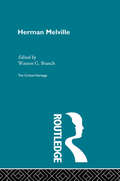- Table View
- List View
Henry Fielding: The Critical Heritage (The\wesleyan Edition Of The Works Of Henry Fielding Ser.)
by Ronald Paulson and Thomas LockwoodThe Critical Heritage gathers together a large body of critical sources on major figures in literature. Each volume presents contemporary responses to a writer's work, enabling students and researchers to read the material themselves.
Henry Ford: Putting the World on Wheels
by Dina El NabliThis is the fascinating story of Henry Ford whose childhood interests led him to leave the Ford family farm in Michigan in search of a career with machinery.
Henry James (Critical Heritage Ser.)
by Roger GardThis set comprises 40 volumes covering 19th and 20th century European and American authors. These volumes will be available as a complete set, mini boxed sets (by theme) or as individual volumes. This second set complements the first 68 volume set of Critical Heritage published by Routledge in October 1995.
Heraldic Design: Its Origins, Ancient Forms and Modern Usage
by Hubert AllcockThrough the ages, as warfare and competitive rituals became more elaborate, heraldry evolved into an exact art and science. Used to denote accomplishments as well as the genealogies of outstanding individuals and families, these symbols survived the way of life that created them.This remarkably rich sourcebook of royalty-free designs describes the origins and ancient forms of heraldic devices, shields, and trademarks. Over 500 black-and-white drawings trace the history and meaning of the coat, shield, crests, helmets, blazonry, and "attitudes and attributes" of symbols, with considerable attention given to devices such as beasts, monsters, and human and part-human figures. American, British, French, Russian, and other coats of arms are displayed, as are insignias of the Pope and clergy, state seals, and emblems of many modern institutions. In addition to personal, commercial, and family arms, chapters also provide information on the use of heraldry in advertising, brand-labeling, and related fields.A valuable visual reference for anyone interested in genealogy, these handsome images will add a touch of class to a variety of art and craft projects.
Heraldic Designs for Artists and Craftspeople (Dover Pictorial Archive)
by J. M. BerglingOver 1,400 heraldic designs depicting shields, coats-of-arms, seals, logos, flags, insignia, scrolls, mottoes, and many other motifs will add a touch of medieval flair or aristocratic ambience to almost any graphic project. Use royalty-free or as a source of design inspiration for an infinite number of print projects.
Heraldry: A Pictorial Archive for Artists and Designers (Dover Pictorial Archive)
by Arthur Charles Fox-DaviesRoyalty-free treasury of 393 full-color, 654 black-and-white illustrations. Authentic heraldic arms, lions, eagles, dragons, shields, crests, windows, etc. Also, arms of cities and towns, arms of Edward the Black Prince, Milton, Maximilian I, others. Add aristocratic flair, noble bearing to almost any graphic project. Publisher's Note. Captions.
Herb & Spice Companion: The Complete Guide to Over 100 Herbs & Spices
by Lindsay HermanYou can spice up your cooking when you learn how to grow, dry, store and use over 100 herbs and spices—from angelica to woodruff, allspice to vanilla.Herb and Spice Companion is your ultimate guide for using fresh and dried herbs and spices in the kitchen. Inside this handy book, get descriptions of more than 100 herbs and spices from around the world. Discover useful tips on storing and using spices to create innovative combinations of flavors. This is the essential guidebook to using herbs and spices to add flavor and depth in your cooking. From basil to beebalm, from lavender to lemon verbena, learn all of the interesting aspects of your herbs, including their rich history, how to grow, harvest, and dry them, and even their unique medicinal uses. This is a must-have for anyone’s cookbook library.
Herb Gardens: Growing herbs and designing, planting, improving and caring for herb gardens (Home Gardener's)
by David SquireThe essential guide to growing herbs and designing, planting, improving, and caring for herb gardens. Herbs are a sheer joy. What else gives so much pleasure to the eye, nose, taste buds, and spirit? Sitting in a garden on a summer&’s evening surrounded by herbs—the visual delight of the flowers and the scent wafting by on the warm air—is unbeatable. This book provides a comprehensive guide to choosing and growing herbs. Concise, easy-to-use reference guide Expert advice about herb-garden design Packed with practice, step-by-step instructions Includes an A-Z directory of culinary herbs How to grow herbs in borders and containers
Herbaceous Perennial Plants: A Treatise on their Identification, Culture, and Garden Attributes
by Allan M. ArmitageThe third edition of the comprehensive—and entertaining—gardening reference by the master horticulturalist.This is the long-awaited third edition of Allan Armitage’s masterpiece on garden perennials. Armitage’s extensive traveling, teaching, and trialing experiences provide a depth of understanding of the best ornamental perennials for North American gardens unparalleled by any other garden writer. One of the most definitive and conclusive books written about perennials, the first edition was designated as one of the best seventy-five books written in the last seventy-five years by the American Horticulture Society. Now the third edition of “The Big Perennial Book” (as it is fondly referred to by many practitioners) describes 3,600 species in 1224 pages. More than three hundred color photos complement detailed text filled with the author’s pointed observations of plant performance, cultivar selection, and current taxonomy. In addition, his trademark wit and passion are both in abundance, making reading as pleasurable as it is informative.
Herbal Remedies Made Simple: A Beginner's Guide to Using Plants, Herbs, and Flowers for Health and Well-Being
by Susan Gregg Stacey Dugliss-WesselmanA do-it-yourself guide to natural healing products, with instructions on choosing plants and recipes for creating alternative wellness solutions at home.Natural alternatives to traditional medicines are everywhere, even right outside your door! Herbal Remedies Made Simple is an easy and fun way to learn about the many different healing herbs that grow all around us but we seldom see. The best part: once you’re familiar with the natural healing herbs around you, Herbal Remedies Made Simple provides you with instructions on creating your own DIY herbal remedies at home.This unique guide book splits its pages in half. The top halves of the pages detail different remedies and recipes for health, personal care, and home care. The bottom pages provide reference material on the herbs used in the project above; detailing the plant’s medicinal properties and how best to work with that herb.Some of the therapeutic recipes within:Lavender cleanserRose water tonerChamomile facial exfoliantComfrey joint and bruise salveNerve tonic tinctureTeas for headaches, stress, sleep, and coldsJoint and muscle soakFully photographed and illustrated, this is the perfect guide for the beginning herbal practitioner.
Herbarium: The Quest to Preserve and Classify the World's Plants
by Barbara M. ThiersA treasury like no other Since the 1500s, scientists have documented the plants and fungi that grew around them, organizing the specimens into collections. Known as herbaria, these archives helped give rise to botany as its own scientific endeavor.Herbarium is a fascinating enquiry into this unique field of plant biology, exploring how herbaria emerged and have changed over time, who promoted and contributed to them, and why they remain such an important source of data for their new role: understanding how the world&’s flora is changing. Barbara Thiers, director of the William and Lynda Steere Herbarium at the New York Botanical Garden, also explains how recent innovations that allow us to see things at both the molecular level and on a global scale can be applied to herbaria specimens, helping us address some of the most critical problems facing the world today. At its heart, Herbarium is a compelling reminder of one of humanity&’s better impulses: to save things—not just for ourselves, but for generations to come.
Herbert Spencer: Collected Writings
by Herbert SpencerHerbert Spencer (1820-1903) was regarded by the Victorians as the foremost philosopher of the age, the prophet of evolution at a time when the idea had gripped the popular imagination. Until recently Spencer's posthumous reputation rested almost excusively on his social and political thought, which has itself frequently been subject to serious misrepresentation. But historians of ideas now recognise that an acquaintance with Spencer's thought is essential for the proper understanding of many aspects of Victorian intellectual life, and the present selection is designed to answer this need. It provides a cross-section of Spencer's works from his more popular and approachable essays to a number of the volumes of the Synthetic Philosophy itself. Volume III.
Herbert Spencer: Collected Writings
by Herbert SpencerHerbert Spencer (1820-1903) was regarded by the Victorians as the foremost philosopher of the age, the prophet of evolution at a time when the idea had gripped the popular imagination. Until recently Spencer's posthumous reputation rested almost excusively on his social and political thought, which has itself frequently been subject to serious misrepresentation. But historians of ideas now recognise that an acquaintance with Spencer's thought is essential for the proper understanding of many aspects of Victorian intellectual life, and the present selection is designed to answer this need. It provides a cross-section of Spencer's works from his more popular and approachable essays to a number of the volumes of the Synthetic Philosophy itself. Volume V: First Principles.
Herbert Spencer: Collected Writings
by Herbert SpencerHerbert Spencer (1820-1903) was regarded by the Victorians as the foremost philosopher of the age, the prophet of evolution at a time when the idea had gripped the popular imagination. Until recently Spencer's posthumous reputation rested almost excusively on his social and political thought, which has itself frequently been subject to serious misrepresentation. But historians of ideas now recognise that an acquaintance with Spencer's thought is essential for the proper understanding of many aspects of Victorian intellectual life, and the present selection is designed to answer this need. It provides a cross-section of Spencer's works from his more popular and approachable essays to a number of the volumes of the Synthetic Philosophy itself. Volume VI The Study of Sociology.
Herbivoracious: A Flavor Revolution, with 150 Vibrant and Original Vegetarian Recipes
by Michael NatkinVegetarian recipes from a food blogger with “a talent for enticing and boldly flavored creations, in recipes that are colorful, thoughtful, and fresh” (Heidi Swanson, New York Times–bestselling author of Super Natural Cooking).In Herbivoracious: A Vegetarian Cookbook for People Who Love to Eat, food blogger Michael Natkin offers up 150 exciting recipes (most of which have not appeared on his blog) notable both for their big, bold, bright flavors and for their beautiful looks on the plate, the latter apparent in more than 80 four-color photos that grace the book. An indefatigable explorer of global cuisines, with particular interests in the Mediterranean and the Middle East and in East and Southeast Asia, Natkin has crafted, through years of experimenting in his kitchen and in loads of intensive give-and-take with his blog readers, dishes that truly are revelations in taste, texture, aroma, and presentation. You’ll find hearty main courses, ranging from a robust Caribbean Lentil-Stuffed Flatbread across the Atlantic to a comforting Sicilian Spaghetti with Pan-Roasted Cauliflower and around the Cape of Good Hope to a delectable Sichuan Dry-Fried Green Beans and Tofu. An abundance of soups, salads, sauces and condiments, sides, appetizers and small plates, desserts, and breakfasts round out the recipes. Natkin, a vegetarian himself, provides advice on how to craft vegetarian meals that amply deliver protein and other nutrients, and the imaginative menus he presents deliver balanced and complementary flavors, in surprising and utterly pleasing ways. The many dozens of vegan and gluten-free recipes are clearly noted, too, and an introductory chapter lays out the simple steps readers can take to outfit a globally inspired pantry of seasonings and sauces that make meatless food come alive.
Herbs & Spices: Over 200 Herbs and Spices, with Recipes for Marinades, Spice Rubs, Oils, and Mor
by Jill NormanThe first illustrated guide to cover the whole spectrum of herbs and spices for culinary use. Herbs & Spices is an indispensable reference that shows how to prepare fresh and dried herbs, how to use herbs and spices in cooking, and details everything that other books on the subject leave out. Containing a unique collection of recipes, from herb and spice mixes to rubs, pastes, salsas, and marinades, these authentic formulas will encourage cooks to think creatively and experiment on their own. Grouped by aroma and taste, with step-by-step preparation techniques and beautiful full-color photography, this book describes 60 herbs and the benefits of using them fresh or dried, and focuses on 60 spices from around the world, with a look at the early spice trade and how cross-cultural fusion has impacted on contemporary cooking.
Herbs Demystified: A Scientist Explains How the Most Common Herbal Remedies Really Work
by Holly PhaneufThe scores of books on herbs already available generally restate old, often outdated lore about herbs. Now, Herbs Demystified does something entirely different: It is the first book to explain exactly what herbs actually do inside our bodies and how they achieve their effects. Biochemist Holly Phaneuf covers 100 of the most popular herbs-astragalus, black cohosh, chamomile, echinacea, garlic, gingko, ginseng, milk thistle, pine bark extract, saw palmetto, valerian, and many others. Phaneuf's introductory overview lays out the basic chemical principles that underlie the journey herbal molecules make in our bodies. Then, for each of the herbs, she covers its history and folklore; explains what the herb really does-its evidence of action; its good uses and not so good uses, including the forms in which it is typically available and commonly reported dosages; interesting facts and the bottom line. Like no other herb book before, Herbs Demystified allows readers to custom-fit an herb to one's own particular concern, therefore minimizing trial and error.
Here Comes the Sun: Radiant Quotes to Warm Your Heart and Brighten Your Day
by Summersdale PublishersLet’s look forward to sunnier times aheadThe sun shines brightest after a storm – and sometimes it even comes with a rainbow. This cheerful collection of wise words and uplifting quotes is a powerful dose of positivity, and the tonic we all need right now. Full of sunny thoughts, pick-me-ups and happiness boosters, Here Comes the Sun will help you look on the bright side and embrace the wonders of a new day. It’s the perfect reminder there will be good times ahead.With a bright, sunny design, this book will bring you good vibes onlyIncludes feel-good affirmations to have you radiating positivity and feeling great in no timeWe all need a little extra cheerfulness in our lives from time to time – Here Comes the Sun is here to deliver it160 pages of joy, with quotes from a diverse range of inspirational people, from the wisdom of Buddha to the feel-good positive vibes of Zendaya
Here Comes the Sun: Radiant Quotes to Warm Your Heart and Brighten Your Day
by Summersdale PublishersLet’s look forward to sunnier times aheadThe sun shines brightest after a storm – and sometimes it even comes with a rainbow. This cheerful collection of wise words and uplifting quotes is a powerful dose of positivity, and the tonic we all need right now. Full of sunny thoughts, pick-me-ups and happiness boosters, Here Comes the Sun will help you look on the bright side and embrace the wonders of a new day. It’s the perfect reminder there will be good times ahead.With a bright, sunny design, this book will bring you good vibes onlyIncludes feel-good affirmations to have you radiating positivity and feeling great in no timeWe all need a little extra cheerfulness in our lives from time to time – Here Comes the Sun is here to deliver it160 pages of joy, with quotes from a diverse range of inspirational people, from the wisdom of Buddha to the feel-good positive vibes of Zendaya
Here We Stand: 600 Inspiring Messages from the World's Best Commencement Addresses
by Randy HoweFor anyone about to embark on the next phase of life, Here We Stand is a unique and inspiring collection of more than 600 quotes drawn from commencement speeches past and recent—by a whole range of very important people including political leaders, actors and actresses, authors, scientists, teachers and professors, philanthropists, artists, military leaders, and activists. The topics include:Ø Seizing the dayØ Finding yourselfØ Traveling the worldØ Goal settingØ Furthering your education and applying what you&’ve learnedØ Recognizing the importance of friendship and familyØ Appreciating what you already have and what you can do for othersØ Dealing with life outside the classroom wallsØ Contributing to the global goodØ Maintaining a positive attitude
Heresy: A History of Defending the Truth
by Alister E. McGrathIn Heresy, leading religion expert and church historian Alister McGrath reveals the surprising history of heresy and rival forms of Christianity, arguing that the church must continue to defend what is true about Jesus. He explains that remaining faithful to Jesus’s mission and message is still the mandate of the church despite increasingly popular cries that traditional dogma is outdated and restricts individual freedom.
Here’s to you!: Creating Your Own Meaningful Toast or Tribute for any Occasion
by Florence IsaacsIs your best friend getting married? Is your boss retiring? Are your parents celebrating their thirtieth anniversary? On these and many other occasions, you’ll probably need to give a toast–and you might well have trouble finding the right words. Fear no more. The bestselling author ofJust a Note to Say…is back withHere’s to You!, an invaluable guide to giving meaningful, personal toasts and tributes on any occasion, including: weddings, graduations, anniversaries, birthdays, holidays, roasts, retirements, promotions, award ceremonies, office gatherings, professional anniversaries "If anyone is going to stand up at your wedding and give a toast, you’ll want to make sure they’ve readHere’s To You!first. It’s chock-full of funny, warm, poignant real-life toasts, as fun to read as they must have been to hear. Any toast-writer will find his creative juices flowing the minute he finishes reading. " –Antonia van der Meer, editor-in-chief,Modern Bride
Heritage Connections (Grade 4 Differentiated Reader Unit 1 Intensive)
by The Editors at the Wright Group-McGraw-HillThe book discusses heritage and the important questions that one needs to know about, like details about ancestors, sharing of culture, things that are passed across generations, etc.
Herman Melville (Critical Heritage Ser.)
by Watson G. BranchThis set comprises 40 volumes covering 19th and 20th century European and American authors. These volumes will be available as a complete set, mini boxed sets (by theme) or as individual volumes. This second set complements the first 68 volume set of Critical Heritage published by Routledge in October 1995.
Hermit Crabs
by Michèle Dufresne<P>The Developing Kit supports students by building a strong reading vocabulary, reading fluency, and comprehension skills. Over the course of a week of lessons, students read a new book each day and a new nonfiction book each week. <P>Each week, they compose a story about something they have learned from reading a nonfiction book and learn about how letters and words work using magnetic letters. Students build a core of words they can read and write. <P>Lessons include guided reading using leveled books, phonics/word work, fluency, comprehension and vocabulary development. Each lesson also includes suggestions for working with second language students.
